Heading out the door? Read this article on the new Outside+ app available now on iOS devices for members! Download the app.
Call it Adventure U: At these 20 colleges and universities, students live outdoor lives as vibrant as their academic ones, backpacking and climbing their way through nearby wilderness with strong outdoor programs.
#20 University of Colorado Boulder
Boulder, CO
Enrollment: 33,246
The Rocky Mountains begin just up the street, and students don’t take their location for granted. In one of the most active cities in the nation, students run, bike, hike, climb, long board, and in-line skate among the 45,000 acres of open space and mountain parks in the county. Never laced up a pair of hiking boots? No sweat. Attend one of the Outdoor Program’s workshops like Intro to Ice Climbing or visit the Adventure Planning Center for trip-planning guidance. In winter, hit the slopes with Boulder Freeride, the largest collegiate ski club in America, which offers a fall camping trip (200 students and a DJ included).
Proximity to the outdoors: 4.8 | Culture: 3.3 | Academics: 3.0
Total: 3.7
#19 Montana State University
Bozeman, MT
Enrollment: 16,703
For MSU students, getting a taste of adventure is a walk in the park. Literally. Bozeman’s “Main Street to the Mountains” trail system provides 80 miles of trails leading to other public trail networks north and south of Bozeman. Surrounded by four national forests and six mountain ranges, the campus is a paradise for its outdoorsy students. “It’s very normal that people have climbed Denali or worked on Rainier,” says Sophie McLoughlin, outdoor program lead trip coordinator from 2014 to 2017. It takes 30 minutes to escape to Bridger Bowl Ski Area and about an hour to get to Big Sky Resort. Or, hit up a whitewater rafting trip in Yellowstone National Park (two hours south) with the Outdoor Recreation Program. The school offers an annual, women-only trip and seminar, and all students have access to essentially any gear, from bear-proof coolers ($11 per day) to river tubes ($10) to a package of avalanche safety gear ($10).
Proximity to the outdoors: 4.8 | Culture: 3.3 | Academics: 3.0
Total: 3.7
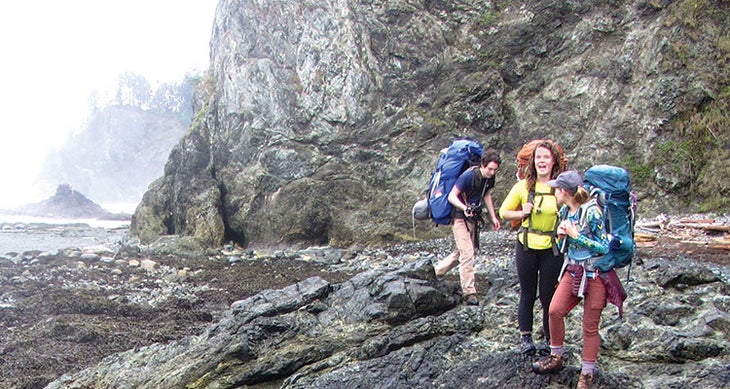
#18 Reed College
Portland, OR
Enrollment: 1,503
Sunlight skims golden trees on an autumn afternoon and a beaver pokes its head out of the creek. No, this isn’t a national forest. It’s Reed Canyon, the 28-acre watershed at the heart of Reed College. And students take care of the campus’s heart, maintaining it during Canyon Day, the oldest tradition (since 1915) at this 111-year-old school. Students regularly journey to the Columbia River Gorge and the Willamette River, and all gear is free to borrow. That, plus proximity, puts multisport days, like an alpine start up Mt. Hood (58 miles) and sunset bonfire on Seaside beach (82 miles), within reach.
Proximity to the outdoors: 4.3 | Culture: 4.0 | Academics: 3.0
Total: 3.8
#17 Whitman College
Walla Walla, WA
Enrollment: 1,510
Whitman might have an idyllic, cloistered campus, but students seem more keen on spending time away in some of the 600 acres of recreational area nearby. Closer afield is Lakum Duckum, a geothermal spring that flows through the heart of campus. Students take advantage: Last year, 40 percent of them were involved with the outdoor program. Environmental studies majors can participate in the “Semester in the West,” a three-month, 8,000-mile-long expedition through the western US where students sleep under the stars and meet in the field with conservationists, foresters, poets, and others.
Proximity to the outdoors: 3.5 | Culture: 4.3 | Academics: 4.0
Total: 3.9
#16 Appalachian State University
Boone, NC
Enrollment: 19,108
Deep in the Blue Ridge Mountains, Appalachian State students worship the land they love—91 percent of the students here are native North Carolinians, and 80 percent say they chose ASU for the outdoor opportunities. “Instead of partying at a bar, they party at a rock,” says Erik Rabinowitz, director of the recreation management program. To turn its students’ outdoor passions into careers, the school connects recreation management majors to internships with organizations like Alaska Mountain Guides and the National Park Service, and any student can earn credit for wilderness certifications such as climbing wall instructor, mountain bike instructor, and Leave No Trace master educator.
Proximity to the outdoors: 4.0 | Culture: 2.7 | Academics: 5.0
Total: 3.9
#15 University of California, Berkeley
Berkeley, CA
Enrollment: 42,519
This #1-ranked university for environmental and ecology programs is a magnet for tree huggers. The eight-week forestry field camp in the Sierra Nevada, open to all majors, has students staying in rustic cabins while studying flora like ponderosa pines and black oaks. Cal Adventures, the university’s outdoor education program, takes students backpacking through Yosemite and Sequoia National Parks, both only about four hours away. A full moon paddle on the San Francisco Bay lets students watch the sun set behind the Golden Gate.
Proximity to the outdoors: 3.3 | Culture: 3.5 | Academics: 5.0
Total: 3.9
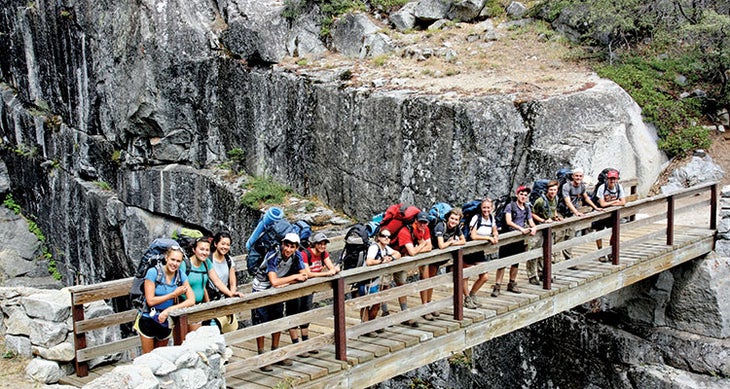
#14 Pomona College
Claremont, CA
Enrollment: 1,671
Bomb down 1,600 vertical feet on skis or take on barreling waves on a surfboard? Students at Pomona College, a small liberal arts school in the foothills of the San Gabriel Mountains, can do both in a single day. They can also snorkel and spelunk while earning a certificate in outdoor leadership. Pomona strives to make the outdoors affordable and available to everyone, so student groups with little to no experience in the outdoors can apply for the Outdoor Engagement Fund and receive up to $500 plus trained leaders from the Outdoor Education Center to guide their trip. Students and professors can take advantage of free or cheap gear rentals and trip-planning service. Or, they can visit On the Loose’s website (the outdoor club of Claremont’s 5 colleges), which has beta on many outdoor trips in the area.
Proximity to the outdoors: 4.5 | Culture: 3.8 | Academics: 3.5
Total: 3.9
#13 Warren Wilson College
Swannanoa, NC
Enrollment: 716
Warren Wilson’s unique triad program—academics, work, and service—brings students outdoors, and the natural environment that surrounds the school provides opportunities for all three. Students might kayak in the French Broad River (14 miles drive away), backpack in the Blue Ridge Mountains (36 miles northeast), care for livestock on the college farm, help manage the recycling center, and, when they need a breather, study in the forest that covers more than half of the campus’s 1,130 acres. Students in the Outdoor Leadership program run challenge courses on the 60-foot obstacle course for community members.
Proximity to the outdoors: 4.0 | Culture: 3.0 | Academics: 5.0
Total: 4.0
#12 Cornell University
Ithaca, NY
Enrollment: 23,600
In the running for the most outdoorsy Ivy Leaguers (along with Dartmouth), Cornell students can earn credit by taking classes in backcountry cooking, dayhiking, and tree climbing. That’s not to mention Cornell’s campus: the Fall Creek and Cascadilla Creek run through it, plus Ithaca itself is dotted with more than 150 waterfalls within 10 square miles. Cornell’s Outing Club has 2,000 members, who, for only $7 per semester, gain access to an extensive gear selection. When academic rigors get too intense (or, it’s just too nice out to study), students de-stress with weekly paddling sessions on Beebe Lake, from April to late October.
Proximity to the outdoors: 4.0 | Culture: 4.2 | Academics: 4.0
Total: 4.1
#11 Bates College
Lewiston, ME
Enrollment: 1,792
After their work is done, Bates students take their outdoorsy play with a little whimsy: Honoring a 44-year tradition, students dress up as bananas, pumpkins, penguins, etc. and plunge into freezing Lake Andrews on campus in January. Outing clubbers bag nearby peaks constantly, and in October, a group of 100 scale Katahdin together. Closer to school, early birds take sunrise paddles on Lake Auburn, while night owls can partake in the “children of midnight” adventures. Despite quirky adventures, students (mainly New Englanders) are serious about their native land. For more than 80 years, they have maintained a 3.5-mile section of the Appalachian Trail.
Proximity to the outdoors: 4.0 | Culture: 4.8 | Academics: 3.5
Total: 4.1
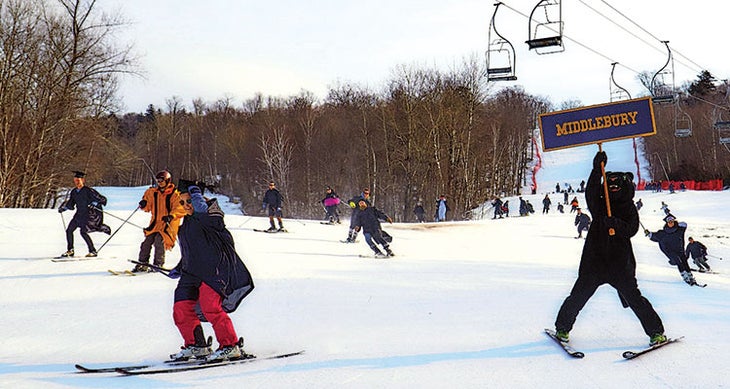
#10 Middlebury College
Middlebury, VT
Enrollment: 2,526
Adventure for free? Why not. With a budget of $5,000, the Mountain Club’s Adventure Grant program compensates students for gas, food, and camping fees, averaging about $250 per trip. Students come with strong academic credentials and interest in the outdoors (environmental studies is the third-most popular major). A lucky 30 students get to live the dream in the Outdoor Interest House where someone is always running down the hallway saying they’re going sledding, skiing, hiking, or fishing.
Proximity to the outdoors: 4.3 | Culture: 4.0 | Academics: 4.0
Total: 4.1
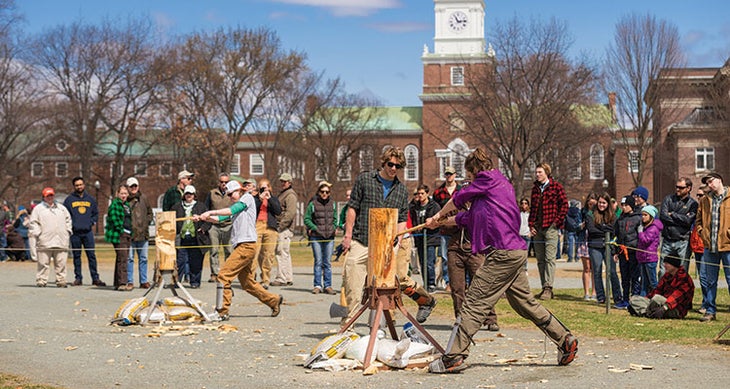
#9 Dartmouth College
Hanover, NH
Enrollment: 6,509
In 1909, to “stimulate interest in out-of-door winter sports,” Dartmouth created the first collegiate outing club, which is now among the largest in the nation with 1,500 members, about a quarter of the student population. Twenty to 30 trips depart weekly among 14 specialty clubs, ranging from patrolling and rescuing on Dartmouth Skiway (the college-owned ski area 20 minutes away) or maintaining 70-plus miles of trails and shelters on the Appalachian Trail. The school pairs high-end academics with easy-access escape, offering 11 cabins for students to rent 9 to 143 miles away. (Perk: Eight cabins are open exclusively to alumni and employees.)
Proximity to the outdoors: 4.2 | Culture: 4.3 | Academics: 4.0
Total: 4.2
#8 University of Utah
Salt Lake City, UT
Enrollment: 31,515
This big, urban campus at the base of the Wasatch Range is where students go to pair powder skiing with academics. In addition to quality research opportunities and top-ranked math and chemistry departments, U of U students get discounts to six different world-class ski resorts, five of which are less than an hour away. By summer, students switch ski boots for climbing shoes, and runners, mountain bikers, and hikers hop on dorm-adjacent trails that extend into the mountains. And if you need to borrow a piece of equipment, the outdoor program is keeper of the nation’s largest gear shed (they claim), available to students for prices from $2 (for a pair of gaiters) on up to $85 (for a whitewater raft).
Proximity to the outdoors: 4.0 | Culture: 4.1 | Academics: 4.5
Total: 4.2
#7 Prescott College
Prescott, AZ
Enrollment: 702
When a college has more vans than classrooms, plan to get outside. These mobile labs bring students to such wonders as the Granite Dells (15 minutes away) or the Grand Canyon (two hours). Those in the five majors under the Adventure Education study area spend almost every sunny day outside teaching local kids about the environment and observing the flora, fauna, and geologic formations close to campus. The school also has a master’s program in Adventure Education.
Proximity to the outdoors: 4.2 | Culture: 3.3 | Academics: 5.0
Total: 4.2
#6 Southern Oregon University
Ashland, OR
Enrollment: 5,970
Nestled between the Siskiyou and Cascade Mountains, this small, artsy public school fits right in with the mountain town’s nature-loving spirit. The Rogue River and Crater Lake National Park are natural laboratories for water quality research and land management studies, while the Outdoor Program helps foster a feeling of community, frequently gathering students for Wonderful Wednesday Eats, gear swaps, and film festivals. Scuba diving and caving clubs’ trips are subsidized by student activity fees, so excursions are cheap. Hoping to make a career out of the outdoors? Major in Outdoor Adventure Leadership and take fly-fishing or mountaineering courses.
Proximity to the outdoors: 4.2 | Culture: 4.0 | Academics: 4.5
Total: 4.2
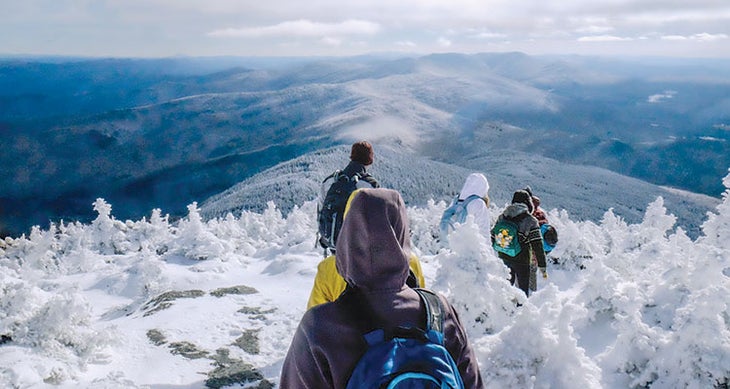
#5 University of Vermont
Burlington, VT
Enrollment: 11,339
When campus seems empty most weekends, don’t look in the library. Check the Centennial Woods a few blocks away, the shores and waters of Lake Champlain, backpacking trails in nearby Maine, or atop Mt. Hunger under a full moon, where students gather with cups of hot chocolate (an Outing Club tradition). The club offers 100 trips annually, and the Ski and Snowboard Club provides free transportation to nearby resorts like Stowe Mountain (45 miles; student pass costs $400), skiers-only Mad River Glen (35 miles), and Sugarbush (50 miles). A $370 season pass scores unlimited days at the two latter. Back on campus, students have their pick from 22 environmental majors and concentrations.
Proximity to the outdoors: 4.7 | Culture: 4.0 | Academics: 4.0
Total: 4.2
#4 Western Washington University
Bellingham, WA
Enrollment: 16,121
It’s hard to beat WWU’s location: Pedal 20 minutes and you’ll find world-class mountain biking at Galbraith Mountain, and drive 90 minutes to a top-notch ski resort (Mt. Baker Ski Area, which holds the record for highest annual snowfall). Plus, the North Cascades are 40 miles to the east and tide pools line the campus’s west side. To help students explore the area, the Outdoor Center organizes multiple trips per weekend. Moreover, at this 100-percent renewable energy campus, students work hard to preserve the nature they enjoy. Western Wilderness Trail Corps maintains trails in the North Cascades, and student volunteers spread the outdoor love by taking community members outside with LEAD, an environmental service club.
Proximity to the outdoors: 4.8 | Culture: 4.0 | Academics: 4.0
Total: 4.3
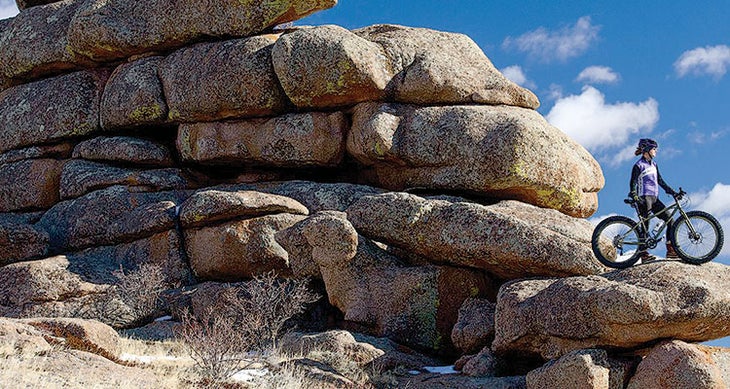
#3 University of Wyoming
Laramie, WY
Enrollment: 13,929
College helps train future leaders, and this university believes roughing it breeds the best ones. The intensive, two-semester Outdoor Leadership Development Series culminates in a week of backpacking without an instructor in southeastern Utah. Students of all majors are encouraged to apply, but just 12 are accepted. Didn’t make the cut? No problem. At Wyoming, it’s easy to find close-to-home outdoor fun in the Snowy Range (42 miles), Vedauwoo Recreation Area (16 miles), or the North Platte River (76 miles). If you don’t know where to go on a weekend, ask someone—most UW students are Wyoming born-and-bred.
Proximity to the outdoors: 4.2 | Culture: 4.2 | Academics: 4.5
Total: 4.3
#2 Northland College
Ashland, WI
Enrollment: 635
A million-acre forest and the country’s largest freshwater lake serve as a laboratory for this school’s nationally ranked outdoor education program (the fifth-most popular major on campus). And then there are the passionate professors. “This summer, I went on a whitewater canoeing trip on the Montreal River in eastern Wisconsin,” says Bronte Goodspeed, a senior. “I texted my professor about it beforehand and she asked if she could join.” Outdoor education majors learn basic sea kayaking, climbing, and wilderness navigation skills, but any student can earn credit for an adventure, like a month-long circumnavigation of Lake Superior.
Proximity to the outdoors: 4.0 | Culture: 4.0 | Academics: 5.0
Total: 4.3
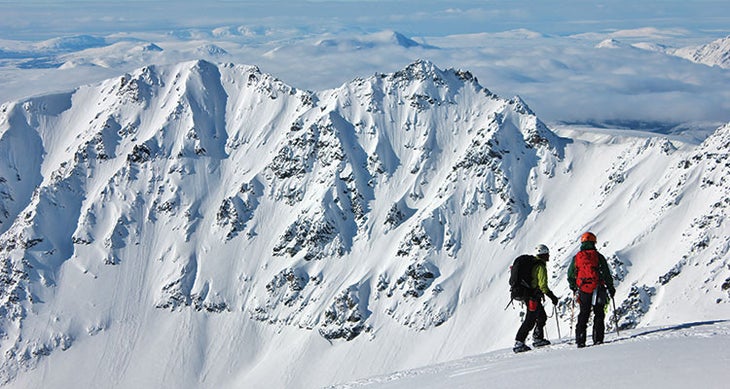
#1 University of Alaska Fairbanks
Fairbanks, AK
Enrollment: 8,336
UAF serves up the adventurous Alaska lifestyle. Think: moose sauntering across the quad, an outdoor program that offers dog mushing and glacier camping, and winter temperatures bottoming out at 60 below. Students shake that chill by climbing the university’s outdoor ice tower, skiing at Hulbert Nanook Terrain Park (both the only of their types on college campuses), and gliding 9 miles of cross-country trails on North Campus, a thousand-acre forest. Matriculants can minor in Arctic skills and take courses that include “hiking through boreal forest and tundra rivers” for credit. The kicker: dorm-window views of the Alaska Range and the Northern Lights.
Proximity to the outdoors: 4.7 | Culture: 4.5 | Academics: 4.0
Total: 4.4
Bonus: Make your breaks count
Want to do some good on your time off? The American Hiking Society’s Alternative Break program sets up college students to do trail maintenance on their spring and winter breaks.
How We Judged the Schools
We reviewed hundreds of schools, rating them on a five-point scale based on three main criteria:
1. Proximity to mountains, trails, rivers, and other outdoor recreational opportunities
2. Culture, evaluated by number of outdoor clubs and participation
3. Quality and diversity of academics for outdoor-related careers